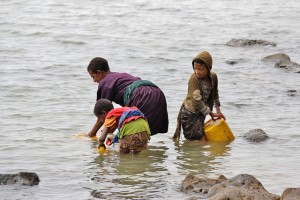Aadita Chaudhury and Sri Ray-Chauduri,Technology & Engineering co-editors
Chances are you’ve heard about Ebola outbreak that has gripped several west African nations. The outcomes of Ebola are far more severe than similar diseases that claim far more lives each year, and the fatality rate is much higher than others such as cholera, typhoid, and dysentery. However, the rate of infection of Ebola is relatively low, and is most easily spread by coming into contact with the bodily fluids and wastes of an infected person.
Like many contagious diseases, the spread of Ebola can be controlled by a sustainable and resilient hygiene and sanitation regimen, often facilitated by public infrastructure for water and sanitation. Thus the role of water and sanitation engineers, along with other stakeholders and members of the public, becomes paramount in limiting the spread of infectious diseases.
Sanitation and wastewater engineers are involved in city planning and work on the infrastructure of water and wastewater facilities and the safety concerns around them. Sanitation and wastewater engineers are often the first line of defense in the spread of infectious diseases, as they ensure that potable water is available to households, and that wastes are separated and disposed of in a safe manner. There is a growing need for safe drinking water solutions around the world for many reasons, most often the lack of good water infrastructure. In fact, 780 million people around the world lack access to safe drinking water on a regular basis.

This water is used for drinking, washing, and bathing. (Photo: marlo_rukh; CC BY-NC-SA 2.0).
The Canadian NGO Engineers Without Borders has devoted a large part of their activities in Africa to raising awareness of and providing solutions to water issues, especially in Malawi, where they work with local people to scale up infrastructure and improve drinking water safety.

Engineers Without Borders, University of Waterloo Chapter (photo: M. Jangda, CC BY-SA 2.0)
If you’re interested in water and sanitation engineering, you may want to explore the work of other organizations, such as Water for People and the Water Environment Federation.
The latest technology & engineering posts from the Science Borealis feed include:
- Ryan Batty at All Roads Lead to Ryan talks about proposed bike lanes and transportation planning in Edmonton.
- Maryse de la Giroday at FrogHeart alerts us to a range of interesting research from using waste cotton to produce cellulose nanoparticles, to making air behave like an optical fibre to guide light beams, and a laundry additive that could possibly help clothes clean urban air.
- And although National Ice Cream month wrapped up in July, FrogHeart draws our attention to a physicist and engineer who has developed an ice cream that changes colour when you lick it – called Xamaleón; it might remind you of Tutti-Frutti!




One thought on “What does Ebola have to do with engineering?”
Comments are closed.